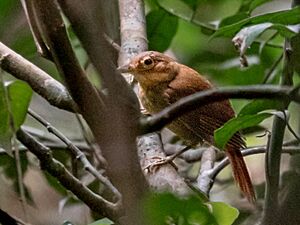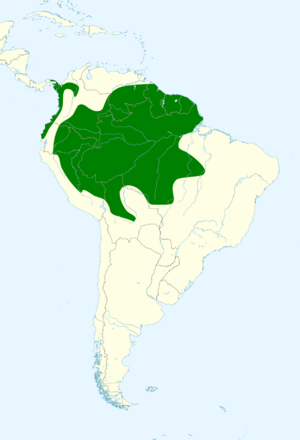Ochre-throated foliage-gleaner facts for kids
Quick facts for kids Ochre-throated foliage-gleaner |
|
|---|---|
 |
|
| Photographed in Rio Branco, Acre, Brazil | |
| Conservation status | |
| Scientific classification | |
| Genus: |
Automolus
|
| Species: |
ochrolaemus
|
 |
|
| Synonyms | |
|
|
The ochre-throated foliage-gleaner (Automolus ochrolaemus) is a type of bird that belongs to the ovenbird family called Furnariidae. You can find this bird in Panama and in most countries in South America. It does not live in Argentina, Chile, Paraguay, or Uruguay.
Contents
How its name changed
The way scientists classify the ochre-throated foliage-gleaner is still being discussed. Until recently, the International Ornithological Committee (IOC) called this bird the "buff-throated foliage-gleaner." It had six different types, called subspecies:
- A. o. cervinigularis (Sclater, PL, 1857)
- A. o. hypophaeus Ridgway, 1909
- A. o. pallidigularis Lawrence, 1862
- A. o. turdinus (von Pelzeln, 1859)
- A. o. ochrolaemus (Tschudi, 1844)
- A. o. auricularis Zimmer, JT, 1935
Other groups, like the Clements taxonomy, had slightly different lists of subspecies.
In July 2023, the IOC decided to split two of these subspecies (A. o. cervinigularis and A. o. hypophaeus) into a brand new species. This new bird is now called the fawn-throated foliage-gleaner. To avoid confusion, the IOC then renamed the remaining four subspecies as the ochre-throated foliage-gleaner. It still uses the original scientific name, A. ochrolaemus. This article follows the model with these four subspecies.
What the bird looks like
The ochre-throated foliage-gleaner is about 18 to 20 cm (7.1 to 7.9 in) long. That's about the length of a large pencil. It weighs between 30 to 46 g (1.1 to 1.6 oz), which is similar to a few AA batteries. This bird is quite large for its group and has a short, strong beak. Both male and female birds look the same.
Colors and markings
Adult birds of the main type, A. o. ochrolaemus, have a dark brownish face. They have a bright, light yellow ring around their eyes and a stripe behind the eye. Their ear feathers have faint reddish lines. The area around their cheeks is a yellowish-orange color with small dark spots.
Their head and the back of their neck are dark brown with a faint, wavy pattern. Their back and rump are a rich dark brown, blending into dark reddish-brown feathers near their tail. Their wing feathers are dark brown, and their flight feathers are a bit lighter and more reddish. Their tail is dark reddish-brown.
The throat of the bird is a deep yellow. Its chest has streaks of medium brown and yellowish-orange. Its belly is brown. The sides of its body are a darker, more reddish-brown, and the feathers under its tail are a dull reddish-brown. The bird's eyes are brown. Its upper beak is dark, and its lower beak is greenish-yellow or gray. Its legs and feet are olive green or greenish-gray.
Young birds
Young ochre-throated foliage-gleaners look a bit duller than adults. Their eye-ring is not as clear, and their face has a reddish tint. Their head has a reddish-brown tint, and their throat and chest might look slightly spotted.
Differences in subspecies
- A. o. pallidigularis is the lightest and dullest type. It has a nearly white throat and dull brown underparts without any yellowish-orange color.
- A. o. auricularis is larger and duller than the main type. Its back is more grayish-olive, and its underparts are lighter with fewer streaks.
- A. o. turdinus has a lighter throat and slightly less yellowish-orange underparts than the main type. Its underparts are somewhere in between the main type and auricularis in color and markings.
Where the bird lives
The different types of ochre-throated foliage-gleaners live in various places:
- A. o. pallidigularis: Found in eastern Panama, northern and western Colombia, and northwestern Ecuador.
- A. o. turdinus: Lives from southeastern Colombia east through southern Venezuela and the Guianas to the Atlantic coast. It also lives south through eastern Ecuador into northeastern Peru and northwestern Brazil, north of the Amazon River.
- A. o. ochrolaemus: Found south of the Amazon River in eastern Peru, western Brazil, and central Bolivia.
- A. o. auricularis: Lives in central Brazil south of the Amazon, between the Rio Purus and Pará state, and south into northeastern Bolivia.
This bird lives in many different types of forests across its very large home range. In Panama, it lives in lowland rainforests and secondary forest (forests that have grown back after being cut down) up to about 1,500 m (4,900 ft) high. In most of the Amazon Basin, it lives in forests that change with the seasons, forests that flood sometimes (called várzea forest), and swamp forests. These areas are usually between sea level and about 1,000 m (3,300 ft) high. West of the Andes mountains in Colombia and Ecuador, it usually lives in secondary forest up to about 800 m (2,600 ft) high. In some places along the Andes, it can be found up to 1,400 m (4,600 ft) high.
Behavior
Movement
The ochre-throated foliage-gleaner stays in the same area all year round. It does not migrate.
Feeding
This bird mainly eats different kinds of insects, spiders, and small vertebrates like tiny frogs. It usually looks for food alone or in pairs. Often, it joins mixed-species feeding flocks, which are groups of different bird species feeding together. It searches for food from the forest floor up to the middle layers of the trees. It is very agile, pulling prey from epiphytes (plants that grow on other plants), bits of dead plants, and especially from clumps of dead leaves. It hops along branches and vines while looking for food. In Central America, people have also seen it looking for food on the ground by flipping over dead leaves.
Reproduction
We don't have much information about how the ochre-throated foliage-gleaner reproduces. The only known description of a nest is from 1929 in Panama. It was a shallow but large cup made of leaf stems. This nest was found inside a chamber at the end of a tunnel. The tunnel was dug into an earthen bank along a stream.
Vocalization
The song of the ochre-throated foliage-gleaner seems similar among its different subspecies. It sings mostly at dawn (sunrise) and dusk (sunset). In Brazil, its song is described as "a series of 3-4 well-separated, descending 'keh-keh-keh-kreh' notes." In Ecuador, it's "a short descending series of clear notes, like 'kee-kee-ke-krr' or 'ki, ki, ki-ki-ke-ke-krr'." Other descriptions from South America include "kee-kee-krr-krr," "jee, jee, ju-ju-ja," and "ki, ki, ke-ke-kukukrrr." Its calls include a "nasal 'rack'" and a "downslurred, dry 'krèeh'."
How the bird is doing
The IUCN (International Union for Conservation of Nature) follows the classification used by BirdLife International. Because of this, they have evaluated the "buff-throated" foliage-gleaner (which includes the ochre-throated foliage-gleaner before the split) as a whole. It is currently rated as being of "Least Concern." This means it is not considered to be in immediate danger of extinction.
The bird lives across an extremely large area. However, its exact population size is not known, and experts believe its numbers might be going down. No immediate threats to the species have been identified. It is generally thought to be common to fairly common in the areas where it lives.


